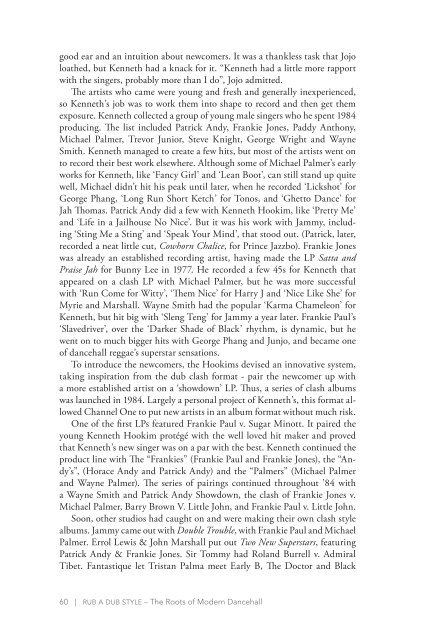You also want an ePaper? Increase the reach of your titles
YUMPU automatically turns print PDFs into web optimized ePapers that Google loves.
good ear and an intuition about newcomers. It was a thankless task that Jojo<br />
loathed, but Kenneth had a knack for it. “Kenneth had a little more rapport<br />
with the singers, probably more than I do”, Jojo admitted.<br />
The artists who came were young and fresh and generally inexperienced,<br />
so Kenneth’s job was to work them into shape to record and then get them<br />
exposure. Kenneth collected a group of young male singers who he spent 1984<br />
producing. The list included Patrick Andy, Frankie Jones, Paddy Anthony,<br />
Michael Palmer, Trevor Junior, Steve Knight, George Wright and Wayne<br />
Smith. Kenneth managed to create a few hits, but most of the artists went on<br />
to record their best work elsewhere. Although some of Michael Palmer’s early<br />
works for Kenneth, like ‘Fancy Girl’ and ‘Lean Boot’, can still stand up quite<br />
well, Michael didn’t hit his peak until later, when he recorded ‘Lickshot’ for<br />
George Phang, ‘Long Run Short Ketch’ for Tonos, and ‘Ghetto Dance’ for<br />
Jah Thomas. Patrick Andy did a few with Kenneth Hookim, like ‘Pretty Me’<br />
and ‘Life in a Jailhouse No Nice’. But it was his work with Jammy, including<br />
‘Sting Me a Sting’ and ‘Speak Your Mind’, that stood out. (Patrick, later,<br />
recorded a neat little cut, Cowhorn Chalice, for Prince Jazzbo). Frankie Jones<br />
was already an established recording artist, having made the LP Satta and<br />
Praise Jah for Bunny Lee in 1977. He recorded a few 45s for Kenneth that<br />
appeared on a clash LP with Michael Palmer, but he was more successful<br />
with ‘Run Come for Witty’, ‘Them Nice’ for Harry J and ‘Nice Like She’ for<br />
Myrie and Marshall. Wayne Smith had the popular ‘Karma Chameleon’ for<br />
Kenneth, but hit big with ‘Sleng Teng’ for Jammy a year later. Frankie Paul’s<br />
‘Slavedriver’, over the ‘Darker Shade of Black’ rhythm, is dynamic, but he<br />
went on to much bigger hits with George Phang and Junjo, and became one<br />
of dancehall reggae’s superstar sensations.<br />
To introduce the newcomers, the Hookims devised an innovative system,<br />
taking inspiration from the dub clash format - pair the newcomer up with<br />
a more established artist on a ‘showdown’ LP. Thus, a series of clash albums<br />
was launched in 1984. Largely a personal project of Kenneth’s, this format allowed<br />
Channel One to put new artists in an album format without much risk.<br />
One of the first LPs featured Frankie Paul v. Sugar Minott. It paired the<br />
young Kenneth Hookim protégé with the well loved hit maker and proved<br />
that Kenneth’s new singer was on a par with the best. Kenneth continued the<br />
product line with The “Frankies” (Frankie Paul and Frankie Jones), the “Andy’s”,<br />
(Horace Andy and Patrick Andy) and the “Palmers” (Michael Palmer<br />
and Wayne Palmer). The series of pairings continued throughout ’84 with<br />
a Wayne Smith and Patrick Andy Showdown, the clash of Frankie Jones v.<br />
Michael Palmer, Barry Brown V. Little John, and Frankie Paul v. Little John.<br />
Soon, other studios had caught on and were making their own clash style<br />
albums. Jammy came out with Double Trouble, with Frankie Paul and Michael<br />
Palmer. Errol Lewis & John Marshall put out Two New Superstars, featuring<br />
Patrick Andy & Frankie Jones. Sir Tommy had Roland Burrell v. Admiral<br />
Tibet. Fantastique let Tristan Palma meet Early B, The Doctor and Black<br />
60 | RUB A DUB STYLE – The Roots of Modern Dancehall


